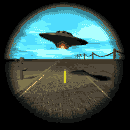
"My first thought was relief," said Evans, who has been working on the project since its inception in 1984. "This is a machine of enormous complexity. Things can go wrong at any time. But this morning has been a great start."
By ALEXANDER G. HIGGINS, Associated Press Writer
GENEVA - The world's largest particle collider passed its first major tests by firing two beams of protons in opposite directions around a 17-mile (27-kilometer) underground ring Wednesday in what scientists hope is the next great step to understanding the makeup of the universe.
After a series of trial runs, two white dots flashed on a computer screen at 10:26 a.m. (0826 GMT) indicating that the protons had traveled clockwise along the full length of the 4 billion Swiss franc (US$3.8 billion) Large Hadron Collider — described as the biggest physics experiment in history.
"There it is," project leader Lyn Evans said when the beam completed its lap.
Champagne corks popped in labs as far away as Chicago, where contributing and competing scientists watched the proceedings by satellite.
Five hours later, scientists successfully fired a beam counterclockwise.
Physicists around the world now have much greater power to smash the components of atoms together in attempts to learn about their structure.
"Well done, everybody," said Robert Aymar, director-general of the European Organization for Nuclear Research, to cheers from the assembled scientists in the collider's control room at the Swiss-French border.
The organization, known by its French acronym CERN, began firing the protons — a type of subatomic particle — around the tunnel in stages less than an hour earlier, with the first beam injection at 9:35 a.m. (0735 GMT).
Eventually two beams will be fired at the same time in opposite directions with the aim of recreating conditions a split second after the big bang, which scientists theorize was the massive explosion that created the universe.
"My first thought was relief," said Evans, who has been working on the project since its inception in 1984. "This is a machine of enormous complexity. Things can go wrong at any time. But this morning has been a great start."
He didn't want to set a date, but said that he expected scientists would be able to conduct collisions for their experiments "within a few months."
The collider is designed to push the proton beam close to the speed of light, whizzing 11,000 times a second around the tunnel.
Scientists hope to eventually send two beams of protons through two tubes about the width of fire hoses, speeding through a vacuum that is colder and emptier than outer space. The paths of these beams will cross, and a few protons will collide. The collider's two largest detectors — essentially huge digital cameras weighing thousands of tons — are capable of taking millions of snapshots a second.
The CERN experiments could reveal more about "dark matter," antimatter and possibly hidden dimensions of space and time. It could also find evidence of the hypothetical particle — the Higgs boson — which is sometimes called the "God particle" because it is believed to give mass to all other particles, and thus to matter that makes up the universe.
The supercooled magnets that guide the proton beam heated slightly in the morning's first test, leading to a pause to recool them before trying the opposite direction.
The start of the collider came over the objections of some who feared the collision of protons could eventually imperil the Earth by creating micro-black holes, subatomic versions of collapsed stars whose gravity is so strong they can suck in planets and other stars.
"It's nonsense," said James Gillies, chief spokesman for CERN.
CERN was backed by leading scientists like Britain's Stephen Hawking , who declared the experiments to be absolutely safe.
Gillies told the AP that the most dangerous thing that could happen would be if a beam at full power were to go out of control, and that would only damage the accelerator itself and burrow into the rock around the tunnel.
Nothing of the sort occurred Wednesday, though the accelerator is still probably a year away from full power.
The project organized by the 20 European member nations of CERN has attracted researchers from 80 nations. Some 1,200 are from the United States, an observer country that contributed US$531 million. Japan, another observer, also is a major contributor.
Some scientists have been waiting for 20 years to use the LHC.
The complexity of manufacturing it required groundbreaking advances in the use of supercooled, superconducting equipment. The 2001 start and 2005 completion dates were pushed back by two years each, and the cost of the construction was 25 percent higher than originally budgeted in 1996, Luciano Maiani, who was CERN director-general at the time, told The Associated Press.
Maiani and the other three living former directors-general attended the launch Wednesday.
Smaller colliders have been used for decades to study the makeup of the atom. Less than 100 years ago scientists thought protons and neutrons were the smallest components of an atom's nucleus, but in stages since then experiments have shown they were made of still smaller quarks and gluons and that there were other forces and particles.
Source Yahoo News
Pointed out to me by Alien Contactee














No comments:
Post a Comment